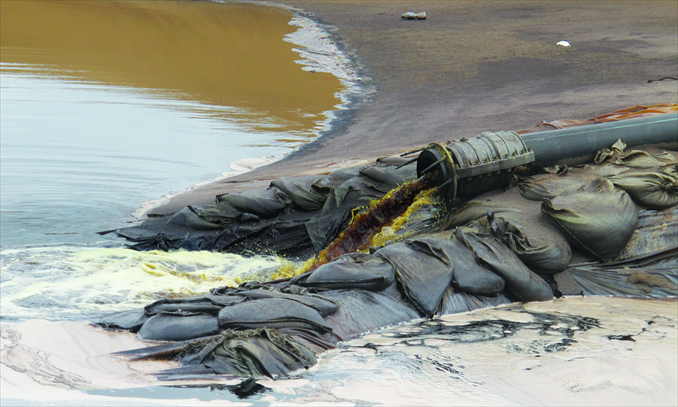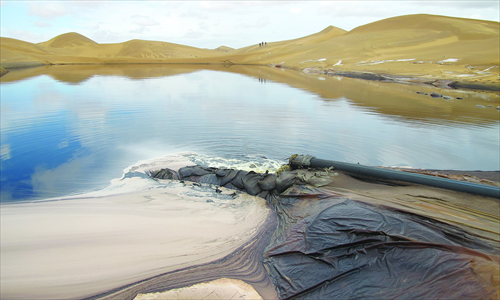|
Global
Times |
|
Jan 23, 2013 |
|
By
Yang Jinghao |
|
|
|
 |
|
|
Unprocessed sewage from chemical plants in the
Tengger industrial park, Inner Mongolia, is
directly discharged into the desert in September
2012. Photo: Shao Wenjie |
|
Bayar,
a 32-year-old herdsman from the Tengger Desert area in Alxa
League, Inner Mongolia Autonomous Region, was heartbroken to
see the country's fourth largest desert being encroached
upon by the local government's "industrial miracle" when he
returned home in 2011 after 13 years away.
Fresh
air, vast rolling dunes, clean underground springs and herds
of camels and cattle - these were the memories he had grown
up with. Unfortunately, such serenity has been torn apart
following the invasion of modern industry. Towering
chimneys, rivers of sewage from the factories and increasing
power-operated wells have created a nightmare for locals.
"I had
been looking forward to going back to the desert without
pollution, but I found I was wrong," Bayar sighed.
Since
early 2000, the local government has been bringing in
enterprises to boost the area's economy. So far, more than
30 chemical enterprises have settled in the Tengger
industrial park, close to Zhongwei city in the Ningxia Hui
Autonomous Region. Official data from the industrial park
management committee shows that the revenue generated by
these enterprises amounted to over 52 million yuan ($8.4
million) in 2010, as compared to the 300,000 yuan the town
of Tengger created in 2000.
But
these glorious economic achievements mask the deteriorating
living environment for local herdsmen, who can't help
worrying about their future, considering that industrial
expansion is not expected to stop anytime soon.
The
issue, highlighting the contradiction between the country's
economic growth model and environmental protection, appears
pressing after the building of "ecological civilization" was
stressed in the 18th CPC National Congress report.
Sewage
invasion
 |
|
|
A pool of
unprocessed sewage from chemical plants in the
Tengger industrial park, Inner Mongolia,
reflects the desert sky in September 2012.
Photo: Shao Wenjie |
|
On May
23 2011, Bayar was on his way to Zhongwei when he suddenly
smelled something offensive and saw several garbage trucks
heading deep into the desert.
He
followed them and found to his dismay that brackish dirty
water from the trucks was being dumped directly into the
sand. This unexpected discovery led to Bayar beginning to
follow this matter closely. He later found two huge pools
into which the sewage was being disgorged through pipes and
without any processing.
The
pools were crudely built without any treatment devices and
were said to have cost 30 million yuan.
"The
pungent odor of the sewage can soon cause sore throats and
weeping eyes. Even the cattle refuse to get close to the
area," Shao Wenjie, a researcher with Nature University, an
environmental protection NGO, told the Global Times.
Actually, what concerns the herdsmen and environmentalists
the most is that the sewage will permeate through the ground
and pollute underground water supplies.
Kang
Jianjun, deputy director of the industrial park, explained
that the two "evaporation pools" were built to dispose of
high-salinity and high-acid sewage that can be recycled
after natural evaporation, the Guangzhou-based Time Weekly
reported.
But
the evaporation of high-concentration sewage only applies to
domestic wastewater, while chemical wastewater has to be
preconditioned since it is made up of complex components,
according to Ma Jun, director with the Institute of Public
and Environmental Affairs.
What
confuses locals even more is that a sewage processing
factory costing 36 million yuan has been left idle since
being established in October 2010. Both officials with the
industrial park and the township said this was because of
the low collection rate of the sewage, saying the factory
would suffer losses if it ever started operation in these
conditions.
After
persistent efforts, the industrial park management committee
issued a circular in October, urging factories to set up
pollutant treatment facilities and process wastewater before
discharging it.
"The
situation is still grave. The sewage is directly released
onto the sand when the pools are full or the pipes burst,"
Bayar told the Global Times, noting that the pools are less
than 2 kilometers away from some families' drinking water
wells. "What's worse, the distance from the industrial park
to the Yellow River is only about 8 kilometers," he said.
Resources pillaged
Apart
from increasingly serious pollution, the herdsmen are facing
another threat - their underground water resources being
plundered by enterprises with high water consumption.
The
Qinghua Group Co. Ltd of Inner Mongolia has dug 40
motor-pumped wells in the desert for its fine chemical
plant, just close to the desert's biggest oasis, each of
which is 160 to 180 meters deep. The water will be sent to a
nearby tower after being extracted and then delivered to the
factory through pipes. "I have been worrying about this
project recently," said Bayar, "Our insufficient water
resources are expected to be further strained once the plant
goes into operation."
Kang
denied the development of these wells would affect the
underground water levels, saying that according to an
evaluation by the regional water authority, the annual water
storage capacity of the evaluated area is 30 million cubic
meters, and that the supply could be balanced as long as the
exploitation didn't exceed set amounts.
It's
not sure how much water the factory will consume when it
starts operation. But it's estimated that it takes an
average of 10 tons of water for the production of 1 ton of
coal products, which could reach 30 tons in producing some
other chemical products.
In the
last decade, underground water resources in Inner Mongolia
have decreased by about 7 percent while demand has grown by
about 40 percent. Currently, the total water resource gap
Inner Mongolia suffers has reached 1 billion cubic meters,
and will reach 3 billion in the next 10 years, according to
a regional conference on water conservation in 2011.
Aware
of this looming threat, the regional government issued a
water conservation regulation in September, forbidding new
high-water consumption projects to use underground water.
The
Party secretary of Tengger township also claimed it was
impossible for the water to dry up given the millions of
cubic meters' of exploitation available. He added that water
from hundreds of miles away would flow to Tengger thanks to
its low-lying terrain.
Zhao
Lianshi, deputy general secretary of the rare species branch
of the China Association for Scientific Expedition, who has
several visits to the desert, is skeptical about this
defense. "The water in the desert is very mysterious and
nobody has ever figured out its sources. Rushed exploration
would lead to some negative consequences such as the
salinization of wetlands and shrinking of green areas," Zhao
told the Global Times.
Meanwhile, unscientific and illegal mining are also plaguing
the locals, and has badly destroyed the grasslands the
cattle graze on. According to Bayar, of the mineral
resources available, few have valuable deposits for
exploitation. Furthermore, the big holes left behind by
former mining operations have scarred the desert and
regularly kill cattle who fall in.
"We
herdsmen have been blamed for destroying vegetation by
excessive grazing. It's these factories that are occupying
our meadows and wrecking the vegetation," said Bayar.
Keeping more than 100 camels as his main source of income,
he said he will have to seek a way out for his animals as
well as his family if the incursion continues.
Persistent efforts
"Leaders, the pollution is serious" read a sign put up by
herdsmen near the factories. In recent years, villagers have
repeatedly appealed to local authorities, but little
progress has been seen.
"Every
time I brought the issue to officials at the industrial park
or the township, they would dodge it under the pretext that
they are working on a solution or the development of the
local economy is important," said Bayar. "The government is
supposed to serve us, but it only fixes its attention on
these enterprises."
Covering an area of 85 square kilometers, the industrial
park is still expanding and is aiming to develop into a
"green ecological" park with annual revenues exceeding 10
billion yuan within several years, Time Weekly quoted the
management committee officials as saying.
Environmentalists from different NGOs nationwide have also
looked into the matter. In November, Shao reported the
matter to the regional environmental protection department
but no response has been received so far.
"We
will have another on-site inspection after the Spring
Festival and may lodge environmental public-interest
litigation against the government or enterprises if the
problem persists," said Shao.
He
told the Global Times that the industrial pollution problem
is also rampant in other areas of Inner Mongolia. The sewage
from an industrial park in Tuoketuo county has seriously
polluted the water resources of local villages, resulted in
a large number of deaths among livestock and harmed
villagers.
In
2007, Liu Jinyin, a 36-year-old villager was poisoned to
death in a pipeline where he was trying to figure out what
was causing the irrigation water, which was badly polluted,
to diminish. His wife and elderly son followed him, ending
up with the same tragedy, according to a Phoenix Weekly
report.
The
surging problems have reflected the dilemma that started
with the nation's western development strategy back in 2000,
under which a large number of enterprises swarmed to western
regions due to preferential policies, especially
high-consuming and high-polluting industries.
Both
local herdsmen and environmentalists familiar with the
matter told the Global Times that the enterprises in the
Tengger industrial park are mainly lured from eastern and
coastal cities, with tax breaks and fewer pollution
treatment restrictions.
Ma
said in the short term, such enterprises can certainly
stimulate the development of local economies, but if
authorities overlook potential risks and negative impacts,
it will be difficult for the western regions to achieve the
anticipated achievements.
Between March and October 2010, Ma Yong, director of the
legal service center with the All-China Environment
Federation, together with his colleagues conducted an
investigation toward 18 industrial parks in eight provinces,
which found all the parks were involved in water pollution
and 13 of them discharge the wastewater to rivers and lakes
directly.
A
report following the survey pointed out that environmental
impact assessments for these enterprises were lacking,
pollution treatment facilities in the parks were basically
of no use and the law enforcement was too lax.
"It's
time to rethink what kind of development we need and how we
should push it forward," said Zhao. "From the equator to the
poles, mountains to plains and forests to oceans, desert is
the last pure place for the humanity. We cannot afford to
lose it."
Agencies contributed to this story |





